Aside from strong financials, competitive advantages are key indicators of a company’s potential for generational wealth building. For reference, highly diversified business models are one of the top advantages of long-term stocks, as they help companies insulate themselves from volatility in a single market, a recession, or other economic risks the world may be facing.
For investors focused on building wealth over generations through investing in long-term stocks, companies like Johnson & Johnson (NYSE:JNJ), Visa NYSE:V), and Procter & Gamble (NYSE:PG) make excellent additions as long-term stocks to buy. With stable business models, strong brands, and a proven history of success and growth, these three long-term stocks can potentially generate substantial gains for decades.
Johnson & Johnson (JNJ)

Johnson & Johnson is one of the long-term stocks to buy. The company has established itself as a go-to powerhouse for shareholders through 63 years of consistent dividend increases. Its diversified operations and brand safeguard it against market fluctuations, allowing financial flexibility to invest in R&D, pursue strategic acquisitions, and increase dividends and share repurchases to deliver value to shareholders.
With a 4.95% increase in its free cash flow (FCF) of $18.6 billion year-on-year (YOY), the company remains well-positioned to continue increasing its dividends.This is supported by quarterly $973 million share repurchases over the past five years on average. JNJ’s relatively low debt-to-equity (D/E) ratio of 44.2% is also well below the 71% of the healthcare industry.
While healthcare faces inherent risks, an aging population and broader global access to care signal growing demand for JNJ’s offerings in the long term. Despite higher costs and upcoming competition for one of its drugs, analysts project an over 10% gain at $162.32 per share.
€‹VISA (V)

Visa is another one of the long-term stock to buy. The company dominates the global electronic payments industry through its leading position in e-commerce, P2P payments, and B2B payments. As the world’s economies continue shifting transactions from cash to digital, Visa’s extensive network cements its dominant role. This is even more relevant now, with the growing emerging markets having a preference for trusted and secure brands.
The company has been growing steadily over the past few years, with earnings growing at an average annual rate of 10.9% and revenues at 9.9%. Driven by transaction volumes and processing fees, Visa beat analyst expectations again recently despite slowing conditions in Asia. With payments and cross-border volumes rising, Visa’s revenue is expected to grow stably due to its business model and trends in consumer spending; it earns fees from facilitating transactions rather than extending credit risk.
Boasting one of the industry’s highest dividend growth over 5 years and having the flexibility to increase dividends through its record 19.73 billion FCF, Visa is a strong candidate for investors seeking wealth in long-term stocks. It also offers potential returns through its authorized $23.6 billion share buyback funds. Despite a slightly higher price-to-earnings (P/E) ratio than the S&P 500, beating EPS estimates for several quarters justifies the marginally higher multiple.
Procter & Gamble (P&G)

Procter & Gamble is another one of the final of the long-term stocks to buy. P&G has established itself as a front-runner in the consumer staples sector through its commitment to paying dividends for 134 years and increasing them for the past 68 years straight. With global operations spanning 180 countries, P&G benefits from economies of scale and supply chain efficiencies that support competitive advantages.
The company generates over $80 billion in annual revenue with solid operating margins and has beaten analysts’ EPS estimates for 18 consecutive quarters, 3.8% to 8.2% on average. With a long history of rewarding shareholders and household names such as Tide, Pampers, Gillette, and Crest, it has proven it can justify repeated price hikes without significantly impacting sales volume.
With over $16 billion in trailing FCF, the company should be able to continue its planned repurchase and dividend programs of $5-$6 billion and $9 billion in 2024 and return the majority of its profits to shareholders. In comparison, the company returned $3.3 billion to shareholders through $2.3 billion in dividend payments and $1 billion in share repurchases in Q3. As it expects operating margins to increase by 22.1% and FCF productivity to 90% in 2024, it satisfies as the last candidate of long-term stocks to buy for decades of gains.
On the date of publication, Stavros Tousios did not have (either directly or indirectly) any positions in the securities mentioned in this article. The opinions expressed in this article are those of the writer, subject to the InvestorPlace.com Publishing Guidelines.
Stavros Tousios, MBA, is the founder and chief analyst at Markets Untold. With expertise in FX, macros, equity analysis, and investment advisory, Stavros delivers investors strategic guidance and valuable insights.
